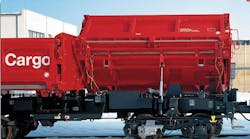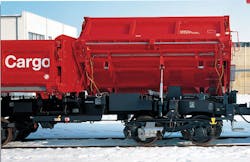If you’ve ever dumped a load of soil from a wheelbarrow, you know there are two ways of getting every particle of dirt out. One is to dump the cart almost completely upside-down so that even dirt stuck to the bottom of the bucket falls out. The other is to pivot the cart skyward and shake it a few times. This agitation loosens clumps of soil that stick to each other and to the bucket.
Having to dump sand, gravel, soil, and other bulk materials from a railroad car can also prove challenging. The trouble is, railroad cars hold so much material that what’s left at the bottom of a load gets pressed onto the bottom and side surfaces of the cargo bed. This complicates unloading because it’s not easy to shake a massive rail car to loosen material adhering to inner surfaces.
Capturing its own energy
An energy-efficient solution to unload bulk materials is the Model 128 rail car developed in Germany. Divided into two 18-m3 bulk-cargo sections, it uses a pair of hydraulic cylinders to raise each section for dumping. Two-way action allows dumping material to be unloaded on either side of the. Each cargo bed is also fitted with eight locking cylinders. Four locking cylinders secure the side hinge opposite the direction in which material will be dumped.
Probably the most unusual aspect of the rail car is its electrical power source — a 26-V, 110-A-hr battery charged by an axle-mounted generator. The generator charges the battery whenever the car is rolling. This makes the entire car self-contained, so it can be unloaded in remote areas with no need for an auxiliary source of power.
Hydraulic power is provided by an electric-motor-driven gear pump. From the pump, fluid is routed through two six-section groups of open and closed-center valves — an identical group for each cargo bed. All valves are operated electrically by a PLC, which also gets its power from the battery.
The PLC simplifies operation by storing the sequence of events that make up the dumping sequence. First, the PLC actuates valves to retract the hinge-locking cylinders on the side to be raised. The cylinders are spring-applied and hydraulically released to ensure that the cargo bed only can be raised during the dumping sequence. Next, fluid is routed to the appropriate double-acting cylinders to raise the cargo bed. A proximity switch in each cylinder signals the PLC once the cylinders reach their full extension. The PLC then instantly signals valves to rapidly and repeatedly reverse flow to shake the upraised cargo bed. Then, the valves shift to return the lift cylinders to their fully retracted position. Once the cargo bed has been fully retracted, pressure to the locking cylinders is relieved to again secure the cargo bed in place.
The entire sequence takes only 2 min, and control is simple: the operator selects which cargo bed will be dumped and in which direction. Pushbuttons provide a means to initiate the sequence, abort the sequence (and return to retracted position), and stop. Operation is much faster, simpler, and more effective than actuating valves manually. Furthermore, time is also saved by not having to locate, connect, and disconnect an external power source.
Successful implementation
The time window to develop a prototype was very limited. As it turned out, two prototypes of the rail car were completed, and testing began only 10 months after the project was initiated. The rail cars went into production following successful testing of the prototypes. Hundreds of the cars have since been produced, and they have been used extensively to transport building materials and waste throughout Germany.


